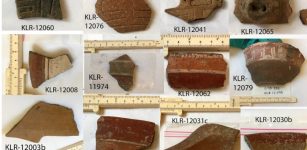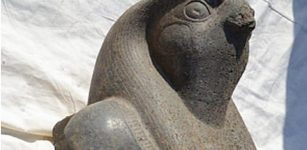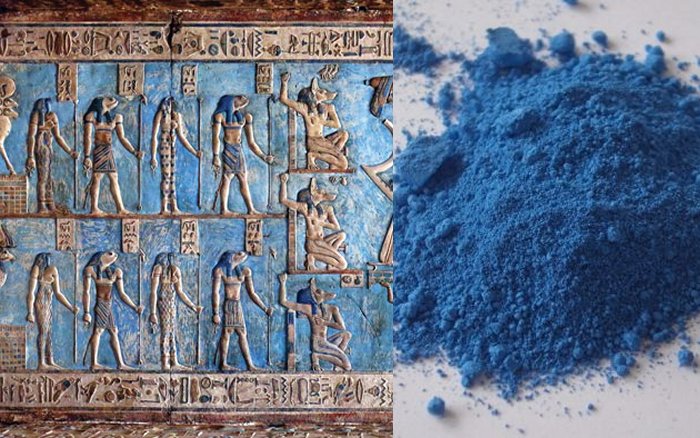Egyptian Blue: World’s Oldest Artificial Pigment
AncientPages.com - Question: What was the Egyptian blue?
Answer: The Egyptian blue is the world’s oldest artificial pigment. It appeared about 5,000 years ago in a tomb painting dated to the reign of Ka-sen, the last king of Egypt's First Dynasty.
Scientists have discovered that the Egyptian blue pigment has extraordinary properties and will enable us not only to reconstruct the past, but also possibly to shape the technological future.
The material giving Egyptian blue its color is calcium copper silicate. It was made by grinding sand, lime and copper (or copper ore) and heating the mixture in a furnace.
See also: Ancient Egyptians Had The First Governmental Health Care System
Egyptian blue was widely used in ancient times as a pigment in painting, such as in wall paintings, tombs, mummies’ coffins and a ceramic glaze known as Egyptian faience. The fact that it was not available naturally meant that its presence indicated a work that had considerable prestige. Its use spread throughout Egypt, Mesopotamia, Greece, and the far reaches of the Roman Empire. It was often used as a substitute for lapis lazuli, an extremely expensive and rare mineral sourced in Afghanistan.
Scientists have noticed that when irradiated with visible light, Egyptian blue emits near-infrared rays with exceptional strength, with even single particles of the pigment detectable from a distance of a few yards.
This suggests Egyptian blue could have a variety of modern applications. For example, it could soon be used in advanced biomedical engineering. Expanding on the ancient Egyptian concept with the pigment's near-infrared-emitting property, scientists can also use it as a nano-ink.
So, the Egyptian blue is certainly more than just a color.
AncientPages.com
Expand for referencesSource:
More From Ancient Pages
-
 What Is The Curse Of The Ninth Symphony?
Ancient History Facts | Aug 3, 2018
What Is The Curse Of The Ninth Symphony?
Ancient History Facts | Aug 3, 2018 -
 Geological Mystery Of The Lost Continent Argoland Solved
Earth Changes | Oct 26, 2023
Geological Mystery Of The Lost Continent Argoland Solved
Earth Changes | Oct 26, 2023 -
 A 2,500-Year-Old Planned City In Tarighat, Chhattisgarh, India
Civilizations | Oct 8, 2014
A 2,500-Year-Old Planned City In Tarighat, Chhattisgarh, India
Civilizations | Oct 8, 2014 -
 Oldest Writing System Among Slavs To Be Germanic Runes – New Study
News | Feb 15, 2021
Oldest Writing System Among Slavs To Be Germanic Runes – New Study
News | Feb 15, 2021 -
 Pharaoh Psusennes I Was Buried In The Silver Coffin Decorated With Gold
Featured Stories | Jan 25, 2021
Pharaoh Psusennes I Was Buried In The Silver Coffin Decorated With Gold
Featured Stories | Jan 25, 2021 -
 Stone Tools In Lapa do Picareiro Cave Reveal Modern Humans Reached Western Parts Of Europe 5,000 Years Earlier Than Previously Thought
Archaeology | Sep 30, 2020
Stone Tools In Lapa do Picareiro Cave Reveal Modern Humans Reached Western Parts Of Europe 5,000 Years Earlier Than Previously Thought
Archaeology | Sep 30, 2020 -
 Emerald Production In Eastern Desert Of Roman Egypt – New Evidence
Archaeology | Apr 16, 2021
Emerald Production In Eastern Desert Of Roman Egypt – New Evidence
Archaeology | Apr 16, 2021 -
 Surprising Diversity Of Ethnic Groups In The US Virgin Islands Before Columbus – New Study
Archaeology | May 18, 2023
Surprising Diversity Of Ethnic Groups In The US Virgin Islands Before Columbus – New Study
Archaeology | May 18, 2023 -
 Baffling North American Ancient Skulls Contradict Historical Timelines And Mainstream Theories
Ancient Mysteries | Jun 11, 2020
Baffling North American Ancient Skulls Contradict Historical Timelines And Mainstream Theories
Ancient Mysteries | Jun 11, 2020 -
 Surprising New Insights Into Use And Increased Production Of Pottery At The End Of The Last Ice Age
Archaeology | Mar 22, 2016
Surprising New Insights Into Use And Increased Production Of Pottery At The End Of The Last Ice Age
Archaeology | Mar 22, 2016 -
 Mystery Of The Maya Blue Pigment And Its Unusual Chemical Composition
Ancient History Facts | Mar 23, 2016
Mystery Of The Maya Blue Pigment And Its Unusual Chemical Composition
Ancient History Facts | Mar 23, 2016 -
 Yamna Culture Started Cannabis Trade 5,000 Years Ago
Ancient History Facts | Aug 6, 2016
Yamna Culture Started Cannabis Trade 5,000 Years Ago
Ancient History Facts | Aug 6, 2016 -
 Discovery Of 1500-Year-Old Celestial Observatory Dated To Sassanian Empire
Archaeology | Mar 16, 2017
Discovery Of 1500-Year-Old Celestial Observatory Dated To Sassanian Empire
Archaeology | Mar 16, 2017 -
 Cornucopia – ‘Horn Of Plenty’ – Ancient Symbol And Its Almost Forgotten Meaning
Ancient Symbols | Jan 14, 2019
Cornucopia – ‘Horn Of Plenty’ – Ancient Symbol And Its Almost Forgotten Meaning
Ancient Symbols | Jan 14, 2019 -
 El Argar Civilization: Bronze Age Palace And Grave Goods Unearthed In Spain’s La Almoloya
Archaeology | Oct 15, 2014
El Argar Civilization: Bronze Age Palace And Grave Goods Unearthed In Spain’s La Almoloya
Archaeology | Oct 15, 2014 -
 What Is Pax Sinica?
Ancient History Facts | Apr 26, 2018
What Is Pax Sinica?
Ancient History Facts | Apr 26, 2018 -
 Anomalies Linked To L-Shaped Structure Detected At The Western Cemetery, Giza, Egypt
Archaeology | May 11, 2024
Anomalies Linked To L-Shaped Structure Detected At The Western Cemetery, Giza, Egypt
Archaeology | May 11, 2024 -
 Colossus Of Standing Falcon-Headed God Horus Unearthed In Egypt’s Luxor
Archaeology | Jan 6, 2020
Colossus Of Standing Falcon-Headed God Horus Unearthed In Egypt’s Luxor
Archaeology | Jan 6, 2020 -
 Prophetic Dream Revealed Priceless Ancient Treasure That Was Later Stolen Or Destroyed – Was The Discovery Too Dangerous?
Ancient Mysteries | Jul 27, 2018
Prophetic Dream Revealed Priceless Ancient Treasure That Was Later Stolen Or Destroyed – Was The Discovery Too Dangerous?
Ancient Mysteries | Jul 27, 2018 -
 The Brujo De Chiloé – The Wild Warlocks Of The Chiloé Archipelago
Featured Stories | May 4, 2022
The Brujo De Chiloé – The Wild Warlocks Of The Chiloé Archipelago
Featured Stories | May 4, 2022

